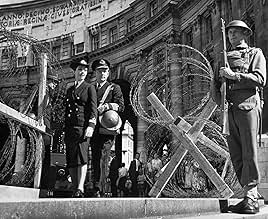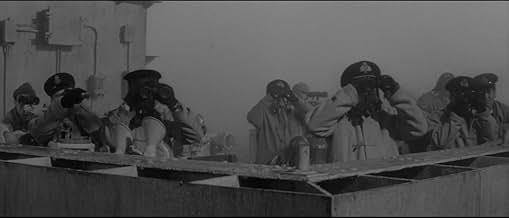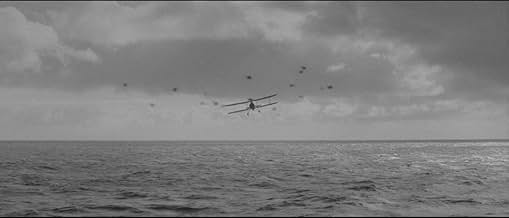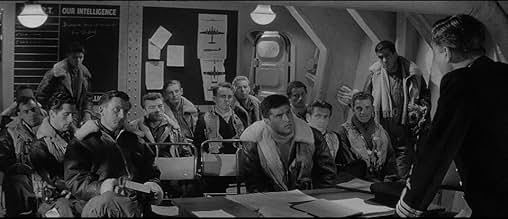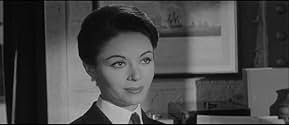"Nello scenario dei ghiacci del Mare del Nord, una leggendaria nave da guerra tedesca, la Bismark domina incontrastata le forze navali alleate. La parola d'ordine degli alleati era ""affonda... Leggi tutto"Nello scenario dei ghiacci del Mare del Nord, una leggendaria nave da guerra tedesca, la Bismark domina incontrastata le forze navali alleate. La parola d'ordine degli alleati era ""affondate la Bismark"".""Nello scenario dei ghiacci del Mare del Nord, una leggendaria nave da guerra tedesca, la Bismark domina incontrastata le forze navali alleate. La parola d'ordine degli alleati era ""affondate la Bismark""."
- Premi
- 2 candidature totali
- Kapitän Ernst Lindemann
- (as Carl Mohner)
- Commodore Wilfrid Patterson - HMS King George V
- (as Jack Gwillam)
Recensioni in evidenza
This otherwise fine film is marred, however, by the false depiction of one of the major characters, Admiral Lutjens, commander of the Bismarck. In the film, he is stereotyped as the typical Nazi - a Hitler sycophant, careerist and wild-eyed fanatic. This was most certainly not the historical Lutjens, who was by no means a Nazi fanatic. Lutjens was a naval hero from World War I, who served out of duty and dedication, not Nazi conviction. (Lutjens protected Jews under his command, and members of his family were in trouble for their anti-Nazi views.) This is at complete odds with his depiction in Sink the Bismarck, which I find inexcusable, given that the above information was certainly available to the production. In fact, an accurate depiction of Lutjens would have, in my opinion, added interest to the plot.
Nevertheless, Sink the Bismarck is eminently watchable and a fine addition to any war movie collection, if you bear in mind the above caveat.
Personally, I found most compelling the strategy and tension within the Admiralty War Headquarters in London, especially the personal depiction of the coordinator of this operation. Kenneth More convincingly plays Captain Jonathan Shepard, who lost his own wife earlier in an air raid and has a son who is himself a naval pilot involved in the battle to sink the Bismarck. Shepard's relationship with the lovely but very professional female naval officer Davis is well captured. There is also a moving portrait of Shepard's restrained response to unfolding news regarding his son. Though there is engaging battle drama at sea, it's the character portrayal of this stiff upper lip British officer that made the movie for me.
I must have seen this movie a dozen times and each time I begin by wondering if I'll be able to sit through it again. (I've got some of the exchanges memorized.) I generally make it, though. It's too good in its own dated way to pass up.
The model work is not bad at all for its time. The reviewer who said this film called for black and white was correct. It looks cold and frightening on the North Atlantic. Almost everything would have been, or at least seemed, gray even if it had been shot in color. The peformances are up to professional standards. More is a different character here from his usual jocular one -- frosty, demanding, and no nonsense. Until finally, overcome with emotion, he breaks down in an understated scene. Dana Wynter, his assistant, spots him and discreetly leaves him alone. She's too beautiful to criticize as an actress. She radiates purity and anima and gently draws More out of his shell. Naismith is a familiar face, as are many of the others. And there is a running gag in this underground bunker where More is plotting the Bismarck's demise. Nobody knows what time it is or, if they know it's 9 o'clock, they don't know if its morning or evening. Even the Germans aboard the Bismarck are lent some humanity by the script writers. The cadets look like earnest fresh-faced kids. The Captain is a practical man, worried about his ship and his crew. Only Karel Stepanek, as Lutjens, belongs in another, much earlier movie, say one made in 1943. He is well out of the frame established in the rest of the film. Stricken with awe when he gets a birthday greeting from You-Know-Who. Some of the dialogue is made up, out of necessity. Who knows what went on on the Bismarck's bridge, especially during that last catastrophic shelling? Back in the bunker, Dana Wynter looks down at the wooden models on her chart where a dozen British warships surround the single Bismarck and pound her to pieces. "I don't feel like cheering," she says. Well, "War is all hell." Maybe that's why human beings seem to need another one every twenty years or so, to remind ourselves.
What a waste of great ships, and of good men, on both sides. And an argument could even be made that Bismarck's sister ship, the Tirpitz, played an even more important part in the war simply by staying put and tying down so many British ships that were needed elsewhere. Our side "wins," of course. Our side almost always wins when we're the side that's funding the movie. A lot of viewers will expectably feel relief when the threat represented by Bismarck is over, but they probably won't feel much like cheering.
The most difficult miniature work was with water and the look of the water in relation to a miniature ship.
It was found that the larger the model ship, the more realistic the water looked, and in Columbia's "Sink the Bismarck", the ships were anywhere from 40-60 feet in length. The water body was an indoor pool over 300 ft. in diameter, surrounded by wind machines and under the floor of the tank, large hydraulic pistons created waves.
Can you imagine what fun that was? Blowing up and sinking these huge models.....it was a dream of mine for years.
Today, a scruffy kid sits in front of a computer and creates sea battles and catastrophes that are astoundingly realistic. He uses 1's and 0's.....nothing of the physical world.
Still, the destruction of the Bismarck, and the capstone piece, the massive explosion of the H.M.S. Hood amaze and awe anyone who watches this film today.
This is a WWII film for the ages, and a centerpiece of a very fun special-effects era.
Part of the problem with this movie is where 20th Century Fox obtained their material from. They used the material in C.S. Forrester's book "The Last Nine Days of the Bismarck". In that book Forrester had portrayed Lutjens as being pro-Nazi which had 20th Century Fox researched before making the movie, would have uncovered Forrester's mistake (intentional or not). A better book was Ludovic Kennedy's "Pursuit: The Chase and Sinking of the Battleship Bismarck," but I don't believe his book had come out at the time the movie was made. 20th Century Fox should have waited until it did than to base a true event on a possibly biased book.
Lo sapevi?
- QuizThe Bismarck's crew was made up of just over two thousand men. Following her sinking, only 114 survivors were rescued from the sea, 110 of them by HMS Dorsetshire and the Tribal-class destroyer HMS Maori. The rescue of survivors was called off by the captain of HMS Dorsetshire amid reports that a U-Boat may be in the area.
- BlooperThe characterization of Admiral Gunther Lütjens in this movie is wildly inaccurate. He is shown as a zealot, a fanatic, denying reality until the end. In fact, Lütjens was a thoughtful, even morose figure - some survivors claimed that his tendency for fatalism damaged their morale. Absurdly, on screen the Admiral tells his men to "remember you are Nazis!" Lütjens was not a Nazi (very much the opposite, to the extent that he famously refused to perform the Nazi salute for Hitler before the Bismarck set sail), nor were the vast majority of his officers and crew.
- Citazioni
[to his assistant Anne Davis, after the battle]
Captain Jonathan Shepard: Take a message: "Request pleasure of the company of Second Officer Anne Davis at dinner."
- Curiosità sui creditiOpening credits prologue: LONDON MAY 1941
- ConnessioniEdited from Duello nell'Atlantico (1957)
I più visti
- How long is Sink the Bismarck!?Powered by Alexa
Dettagli
- Data di uscita
- Paesi di origine
- Lingue
- Celebre anche come
- ¡Hundan al Bismarck!
- Luoghi delle riprese
- Azienda produttrice
- Vedi altri crediti dell’azienda su IMDbPro
Botteghino
- Budget
- 1.330.000 USD (previsto)
- Tempo di esecuzione1 ora 37 minuti
- Colore
- Mix di suoni
- Proporzioni
- 2.20 : 1
- 2.35 : 1
Contribuisci a questa pagina



